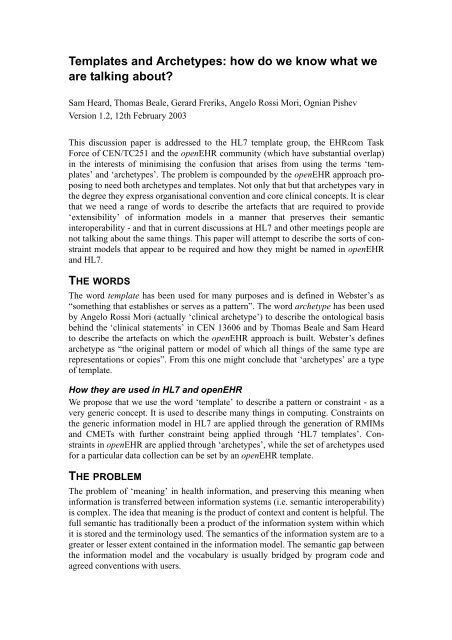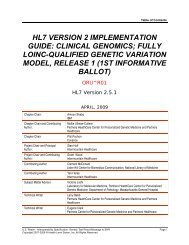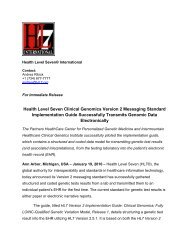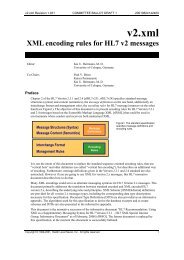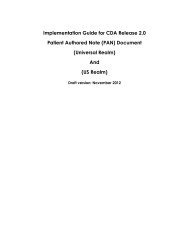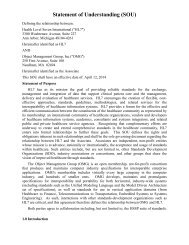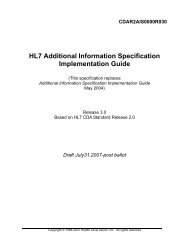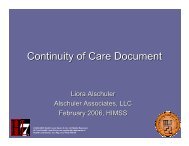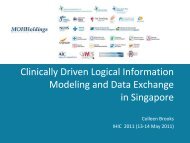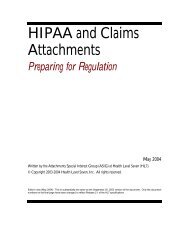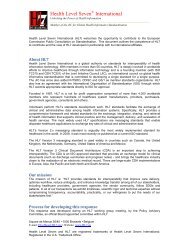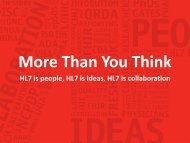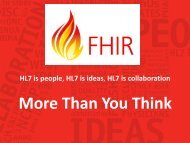Templates and Archetypes GF.fm - HL7
Templates and Archetypes GF.fm - HL7
Templates and Archetypes GF.fm - HL7
You also want an ePaper? Increase the reach of your titles
YUMPU automatically turns print PDFs into web optimized ePapers that Google loves.
<strong>Templates</strong> <strong>and</strong> <strong>Archetypes</strong>: how do we know what weare talking about?Sam Heard, Thomas Beale, Gerard Freriks, Angelo Rossi Mori, Ognian PishevVersion 1.2, 12th February 2003This discussion paper is addressed to the <strong>HL7</strong> template group, the EHRcom TaskForce of CEN/TC251 <strong>and</strong> the openEHR community (which have substantial overlap)in the interests of minimising the confusion that arises from using the terms ‘templates’<strong>and</strong> ‘archetypes’. The problem is compounded by the openEHR approach proposingto need both archetypes <strong>and</strong> templates. Not only that but that archetypes vary inthe degree they express organisational convention <strong>and</strong> core clinical concepts. It is clearthat we need a range of words to describe the artefacts that are required to provide‘extensibility’ of information models in a manner that preserves their semanticinteroperability - <strong>and</strong> that in current discussions at <strong>HL7</strong> <strong>and</strong> other meetings people arenot talking about the same things. This paper will attempt to describe the sorts of constraintmodels that appear to be required <strong>and</strong> how they might be named in openEHR<strong>and</strong> <strong>HL7</strong>.THE WORDSThe word template has been used for many purposes <strong>and</strong> is defined in Webster’s as“something that establishes or serves as a pattern”. The word archetype has been usedby Angelo Rossi Mori (actually ‘clinical archetype’) to describe the ontological basisbehind the ‘clinical statements’ in CEN 13606 <strong>and</strong> by Thomas Beale <strong>and</strong> Sam Heardto describe the artefacts on which the openEHR approach is built. Webster’s definesarchetype as “the original pattern or model of which all things of the same type arerepresentations or copies”. From this one might conclude that ‘archetypes’ are a typeof template.How they are used in <strong>HL7</strong> <strong>and</strong> openEHRWe propose that we use the word ‘template’ to describe a pattern or constraint - as avery generic concept. It is used to describe many things in computing. Constraints onthe generic information model in <strong>HL7</strong> are applied through the generation of RMIMs<strong>and</strong> CMETs with further constraint being applied through ‘<strong>HL7</strong> templates’. Constraintsin openEHR are applied through ‘archetypes’, while the set of archetypes usedfor a particular data collection can be set by an openEHR template.THE PROBLEMThe problem of ‘meaning’ in health information, <strong>and</strong> preserving this meaning wheninformation is transferred between information systems (i.e. semantic interoperability)is complex. The idea that meaning is the product of context <strong>and</strong> content is helpful. Thefull semantic has traditionally been a product of the information system within whichit is stored <strong>and</strong> the terminology used. The semantics of the information system are to agreater or lesser extent contained in the information model. The semantic gap betweenthe information model <strong>and</strong> the vocabulary is usually bridged by program code <strong>and</strong>agreed conventions with users.
Burying the semantic representation in the information system itself is a costlyapproach. The consequence is that meaning that cannot be expressed through an evolvingterminology service must be dealt with by changing the information system itself.In health care, where development of concepts is rapid <strong>and</strong> continuous <strong>and</strong> where thereis a wealth of different work settings, we have particular insight into this difficulty. Ifwe are to have stable information models <strong>and</strong> stable software a new approach isrequired. This approach (outlined in “<strong>Archetypes</strong> - An Interoperable Knowledge Methodologyfor Future-proof Information Systems” by Thomas Beale 1 ) allows modellingof domain concepts external to the system information model. Many information systemstoday utilise metadata - often similar to the archetype approach - but the formalarchetype methodology is an innovation.<strong>HL7</strong>, as a st<strong>and</strong>ards organisation, concentrates on the design of generic informationmodels that can be used in different contexts. The result is that a gap, similar to that inEHR systems, presents itself between the capabilities of the RIM derived models <strong>and</strong>the semantic requirements of a diverse set of users. As a consequence there is an evenlarger gap between the necessarily generic information model <strong>and</strong> the vocabularysemantics.Figure 1: The semantic gapInformation modelTHE GAPVocabularyWordsTermsPhrasesOne further feature of this ‘gap’ is that different users at different sites will have a verystrong preference for how information is best organised or presented, <strong>and</strong> what informationwill be required or collected for different purposes. This provides a strong pressureto keep domain information out of the information model itself <strong>and</strong> in theconstraint model to meet the need for specialisation <strong>and</strong> extensibility of the informationmodels. It is worth noting that some information, such as the recording ‘context’such as dates, times <strong>and</strong> participations, are best retained in the information model, asthese must be controlled.What sorts of ‘things’ are in an EHR?Consider the sorts of aggregations that might be considered discrete <strong>and</strong> whole concepts<strong>and</strong> might appear in an EHR.1. A collection of concepts that together form fixed attributes of a higher levelconcept that is not recorded as its component parts alone - e.g.:∞ a blood pressure measurement with its two pressure measurements, patientposition, cuff size etc.∞ a body weight with details about the baby’s state of undress <strong>and</strong> the deviceused for measurement2. A generic concept (with other fixed attributes) that is a value or a collectionof values which form a subset of a larger (or very large) known set - e.g.:1. http://www.deepthought.com.au/it/archetypes.html
∞ a diagnosis - the value - with fixed attributes such as the date of onset, thestage of the disease etc∞ a laboratory battery result which includes an arbitrary set of values - the collection- with fixed attributes such as the time of sampling, or a challengeapplied to the patient at the time the sample was taken (e.g. fasting).3. A collection of these higher level concepts that are usually measuredtogether <strong>and</strong> might be considered themselves concepts - e.g.:∞ Vital signs - with temperature, blood pressure, pulse <strong>and</strong> respiratory rate∞ Physical examination - with for example observation, palpation <strong>and</strong> auscultation(<strong>and</strong> other findings)4. A collection of these aggregrations which might form a record compositionor a document - e.g.:∞ A clinic progress note containing symptoms, physical examination, an assessment<strong>and</strong> a plan∞ A laboratory report that contains the results as well as interpretation <strong>and</strong>details about any notifications <strong>and</strong> referrals that have been made∞ An operation report detailing the participants <strong>and</strong> their roles, a description ofthe operation, any complications <strong>and</strong> followup monitoring <strong>and</strong> care requiredThe heirarchical aggregation at higher levels, such as the level of the document or thedocument section, will be more informed by best practice, use-cases <strong>and</strong> convention<strong>and</strong> have less impact on the semantics. This must be true or the meaning of healthinformation in a health record would require the precise underst<strong>and</strong>ing of the contextof its recording before it could be safely reused. Consider having to know the contextof a pulse measurement in detail before you could review a person’s pulse rate over thelast 2 years, or for that matter, their blood pressure. There is no doubt that knowingsomeone was pregnant might alter interpretation of blood pressure readings - but themeasurements remain systemic arterial blood pressure values despite the altered physiologicalstate.It is also worth noting that default values of the lower level concepts can usefully beset in certain situations - <strong>and</strong> so might be features of the higher level aggregations. Anexample might be that a blood pressure is virtually always measured in the sitting positionin a midwife antenatal clinic. This would not be so in a cardiology clinic.THE SOLUTIONSolutions have been proposed to bridge the semantic gap <strong>and</strong> allow for the specialisationrequired by different users. In the openEHR work these are called archetypes <strong>and</strong>are the single means of achieving interoperability with a generic information model. In<strong>HL7</strong>, two means are used - a constrained version of RIM classes creating a specificinformation model called an RMIM <strong>and</strong> then a means of constraining this furthercalled a ‘template’. Both solutions have attempted to address the gap described above– the semantic gap <strong>and</strong> the need for specialisation <strong>and</strong> extensibility – enabling moregeneric, <strong>and</strong> hopefully stable, information models. Both approaches rely on vocabularyto populate these models.Semantic considerationsSemantic meaning of an artefact is derived from definitions <strong>and</strong> its relationships withother artefacts of the same type, <strong>and</strong> related artefacts derived from the same knowledgebase. This approach has, until now, been predominantly the domain of terminolo-
gies, though often without explicit definitions. With the increased availability ofontological tools (such as Protégé) <strong>and</strong> underst<strong>and</strong>ing of the requirements for preservingsemantics (such as CEN’s categorial structure), more information systems areusing knowledge tools <strong>and</strong> basing their systems on ontologies (<strong>and</strong> models).Any information construct, ‘archetype’ or ‘template’, that aims to preserve semanticsmust be related in some formal way to an ontology. Given requirements for extensibility<strong>and</strong> specialisation mentioned above, a strict rule set must be developed which governshow this might be achieved. Further, each concept represented as a template orarchetype <strong>and</strong> defined in an ontology will have to be discrete <strong>and</strong> complete. If not,there will be no limit to the complexity <strong>and</strong> relationships of these concepts.Figure 2: Controlled <strong>and</strong> uncontrolled archetype developmentControlled concept developmentUncontrolled developmentAA1BA1.1 A1.2The aim of these constructs is to convey meaning <strong>and</strong> as such re-use should be maximised<strong>and</strong> the number of these minimised. This will curtail complexity – somethingthat has been very difficult to manage using vocabulary alone.We propose that the concepts described above are represented as ‘strong semanticmodels’ - <strong>and</strong> that these should be linked to an ontology <strong>and</strong> called ‘primary archetypes’.They will have the following features:• The need for these models is to provide semantic interoperability• These models should represent whole <strong>and</strong> discrete concepts that cannot easilybe dealt with by terminology alone:∞ They may require values as well as terms∞ They are compound <strong>and</strong> simplify the need for complex vocabularies as wellas allowing other relevant properties to be recorded∞ They are widely held concepts that are required for automatic processing• These models are stored, at least in their generic form, in a knowledge base thatis linked to a formal ontology. This ontology may support complex queries inan information system.• These models will be registered by a st<strong>and</strong>ards body in a jurisdiction (the country,the region or a sector of health care)Use considerations – specialisation <strong>and</strong> extensibilityThere are many considerations about how information is stored in an EHR that arerequired for specific use but do not directly affect semantic interoperability. For example,a ‘diabetic care message’ <strong>and</strong> a ‘CDA cardiology report’ might contain a bloodpressure measurement taken on the same patient. The re-use <strong>and</strong> meaning of the bloodpressure is not changed substantively (<strong>and</strong> certainly not semantically) from an automaticprocessing point of view by its recording in these contexts. Likewise, a medica-
tion order in hospital or primary care are semantically equivalent <strong>and</strong> will oftencontinue to be relevant after transfer from one care setting to another.It is apparent that there are two levels that the recordings are specialised <strong>and</strong> extended- organisation <strong>and</strong> specific entries <strong>and</strong> values. I will consider each of these separately.Organisational modelsThere are shared models that apply across different settings <strong>and</strong> relate to record organisation.Examples are the recording of a clinician-patient interaction in a traditionalmanner - history, physical examination, diagnosis, management etc <strong>and</strong> a problem orientedapproach where the SOAP model might be invoked multiple times in one recordunder a different problem heading.Figure 3: Traditional <strong>and</strong> problem oriented organisationHistoryHeadacheToothachePhysical examOptic Fundi normalSwelling under R4 molarDiagnosesTooth abcessToothacheS: Painful tooth on RO: Swelling under R4 molarA: Tooth abcessHeadacheS: Overnight - poor sleepO: Optic fundi normalA: Secondary to toothacheThe organisation of a diabetic care message <strong>and</strong> a CDA cardiology report may vary indifferent settings - although, with increasing communication, alignment will be helpful.However, it is likely that organisational models will be st<strong>and</strong>ardised in a particularlocality or institution, <strong>and</strong> that this might - with time - extend to a wider realm.If the information model is sufficiently generic then there is a need for an artefact toexpress these ‘organisational’ constraints, recognising that while they express someknowledge, the meaning of the ‘archetyped’ information that these models ‘organise’is not altered. Such organisational models may well (<strong>and</strong> even perhaps will usually)restrict the archetyped models that may sensibly appear at this point in the EHR. Considerthe “O:” in the problem oriented example above. It would be sensible to limitwhat would usually appear here to observations of the patient. We propose that theseconstraints are called ‘organisational’ models - organisational ‘archetypes’.The features of ‘organisational’ archetypes are:• The need for these models is based on use-cases – local or more general - butstill has strong links with the knowledge base. Thus a section called ‘physicalexamination’ <strong>and</strong> ‘examination of the abdomen’ can be known to be related.• There need be no restriction on the number of these artefacts but their relationshipsshould be understood• These models carry no primary semantic content - but the efficiency of humans<strong>and</strong> machines to query or read the meaning of the finer grain content would bediminished• Re-use of these models is encouraged – for aiding information navigation byusers• There is no need for registration of these models for semantic interoperability• These models may not be present in the ontology
It is important to recognise that organisational models will have slots that can be filledby further organisational archetypes or archetypes.These organisational ‘archetypes’ will describe the ‘organisers’ in openEHR <strong>and</strong> the‘sections’ in <strong>HL7</strong> CDA. While the names of these headings do not alter the semanticsof the information structures held within them they do imply some knowledge - <strong>and</strong>may be derived from the meaning of the term used to label them.Constraint during data captureA further level of artefact is required in EHR systems - one which specifies the use ofthe ‘organisational’ <strong>and</strong> ‘primary’ archetypes within a document or other record constuct.This will be as specific as is required by a group of users <strong>and</strong> may be sharedwidely or not at all. These specifications have a firm foundation in specific environments<strong>and</strong> user preferences. The role of these specifications (which are called ‘templates’in openEHR to differentiate them from archetypes) describe how the entries inthe record are organised <strong>and</strong> specify what optional elements in the entries will be populated<strong>and</strong> what values <strong>and</strong> default values apply.While these may well be registered for reuse, they will arise from consideration of bestpractice, specific dem<strong>and</strong>s for quality care, decision support systems <strong>and</strong> applicationrequirements.Consider an openEHR template for recording an antenatal care contact.Figure 4: openEHR antenatal template exampleHistorySymptomsConcernsPhysical examOrganisationalBlood pressureOntologicalmodelsFetal heart ratemodelsPalpation of abdomenAssessmentPlanThe openEHR ‘template’ or constraint specification will show which organisationalmodels are used, in which order, <strong>and</strong> which ‘primary’ archetypes these will contain. Itwill also set appropriate default values in the primary archetypes if required <strong>and</strong>describe, in the case of the antenatal examination, how the palpation ‘archetype’ isspecialised to enable the position of the fetus in the uterus to be described. 1The new use of ‘Primary’ <strong>and</strong> ‘Organisational’ archetypes <strong>and</strong> templatesIn summary, I propose that the term ‘template’ is used in <strong>HL7</strong> <strong>and</strong> openEHR todescribe a constraint specification for a message, a document or a fragment of this -always in terms of primary <strong>and</strong> organisational archetypes - <strong>and</strong> in addition in <strong>HL7</strong>1. It is worth noting that the openEHR approach would allow a generic ‘palpation’ archetype to be specialisedfor use in pregnancy only - <strong>and</strong> perhaps called ‘palpation of the pregnant abdomen’.
RMIM classes <strong>and</strong> CMETs. The term archetype is used to describe concepts that arerecorded in the EHR which can be usefully linked to an ontology.Table 1: Naming considerationsNameDescriptionCurrentopenEHRCurrentCDACurrent<strong>HL7</strong>messagesPrimaryarchetypeOrganisationalarchetypes<strong>Templates</strong>Discrete whole conceptsrecorded in EHRRepresent concepts usedto organise EHR <strong>and</strong>may constrain the containedprimary archetypesConstraint specificationsexpressed in termsof organisational archetypes<strong>and</strong> primary archetypesEntryarchetypesOrganiserarchetypesEntry templates<strong>and</strong> RMIMclasses <strong>and</strong>CMETsSectiontemplates<strong>Templates</strong> ? ?RMIMclasses <strong>and</strong>CMETs?During detailed discussion, the terms templates, organisational archetypes <strong>and</strong> primaryarchetypes should be used. The <strong>HL7</strong> <strong>and</strong> openEHR communities would need to agreethat:• The semantics of the <strong>HL7</strong> may reside partly in the RIM, partly in the RMIM(<strong>and</strong> CMETs) <strong>and</strong> partly in the primary archetypes. Matching the semanticswith the openEHR archetype may prove difficult in the message world - butshould be easier in the somewhat aligned CDA world.• The semantics of the openEHR archetypes reside in the archetype alone -which is linked to an ontology.• The need to register primary <strong>and</strong> organisational archetypes is absolute - howmany are required for use with the CDA is not clear as the power of the semanticsexpressed in the current version 2 RMIM has not been tested. openEHR islikely to require a few hundred to achieve reasonable interoperability.• The primary archetypes are at the level of the ‘ENTRIES’ in the CDA RMIM<strong>and</strong> the openEHR reference model - providing an opportunity for covergentwork.For the <strong>HL7</strong> community, organisational archetypes will apply to CDA SECTIONS, <strong>and</strong>some messages. Primary archetypes will apply to CDA ENTRIES where the model isrequired for semantic interoperability <strong>and</strong> the full semantic is not provided by theRMIM. In openEHR, ‘organisational’ archetypes will apply to ORGANISERS <strong>and</strong> ‘primary’archetypes will apply to openEHR ENTRIES.The ‘templates’ with the weakest links to the knowledge base <strong>and</strong> the strongest link toquality <strong>and</strong> practice - will apply to predominantly to <strong>HL7</strong> CDA documents, openEHR
transactions or compositions <strong>and</strong> to complete messages. The guide is that these areonly expressed in terms of organisational <strong>and</strong> primary archetypes.In the current proposed approach by the <strong>Templates</strong> SIG, primary archetypes would alsoapply to RMIM segments where there was a need for semantic differentiation.Figure 5: The relationship of the artefactsUseRe-use<strong>Templates</strong>openEHR templateCDA document template Organisational<strong>HL7</strong> message template archetypesopenEHR organiser archetypeCDA section templatePrimaryarchetypesopenEHR entry archetypeCDA entry templateConvention(best practice)Semantics(knowledge)The proposal to use both the terms templates <strong>and</strong> archetypes in a specific manner, hasconsiderable advantages for the following reasons:• The EHR SIG <strong>and</strong> <strong>HL7</strong> <strong>Templates</strong> group can use the same language to describedifferent artefacts shared by both communities.• The essentially different artefacts will be differentiated by name, thus avoidingconfusion when using the term template generically.• The technology to express both ‘organisational’ <strong>and</strong> ‘primary’ archetypes canbe the same in each setting.• A shared ontology of key concepts – ‘primary archetypes’ - that fill the semanticgap between information models <strong>and</strong> terminology can be developed in acontrolled environment.• A shared registry of ‘organisational’ archetypes can grow in a less controlledmanner in response to specific use environments.• A shared registry of templates that allow localisation <strong>and</strong> extensibility cangrow in an open <strong>and</strong> collaborative manner.The resulting view of the information space involves 4 key components:• The information model (RIM/RMIM or openEHR reference model)• <strong>Templates</strong> which express the data entry requirements in a particular situation• The organisational archetypes - supporting navigation <strong>and</strong> style or ‘clinicalinteroperability’• The primary archetypes - supporting semantic interoperability• The vocabulary - supporting semantic interoperabilityFigure 6: The semantic space<strong>Templates</strong>Information modelOrganisationalarchetypesPrimaryarchetypesVocabularyWordsTermsPhrases
“How things are stored does not reflect on what they mean - returns from a query areusually based on the meaning...” Alan RectorPlease send comments to:sam.heard@bigpond.com


